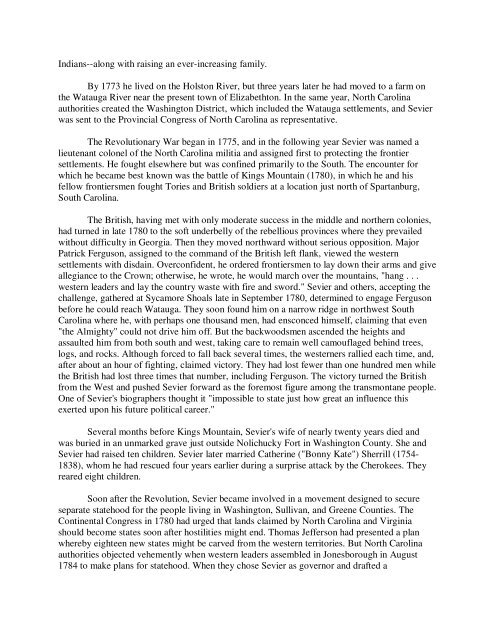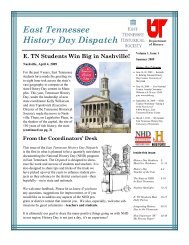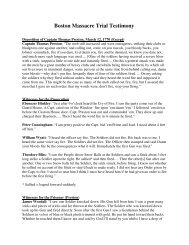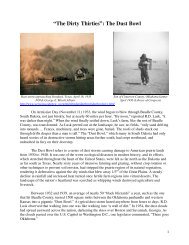John Sevier - Teach American History
John Sevier - Teach American History
John Sevier - Teach American History
You also want an ePaper? Increase the reach of your titles
YUMPU automatically turns print PDFs into web optimized ePapers that Google loves.
Indians--along with raising an ever-increasing family.<br />
By 1773 he lived on the Holston River, but three years later he had moved to a farm on<br />
the Watauga River near the present town of Elizabethton. In the same year, North Carolina<br />
authorities created the Washington District, which included the Watauga settlements, and <strong>Sevier</strong><br />
was sent to the Provincial Congress of North Carolina as representative.<br />
The Revolutionary War began in 1775, and in the following year <strong>Sevier</strong> was named a<br />
lieutenant colonel of the North Carolina militia and assigned first to protecting the frontier<br />
settlements. He fought elsewhere but was confined primarily to the South. The encounter for<br />
which he became best known was the battle of Kings Mountain (1780), in which he and his<br />
fellow frontiersmen fought Tories and British soldiers at a location just north of Spartanburg,<br />
South Carolina.<br />
The British, having met with only moderate success in the middle and northern colonies,<br />
had turned in late 1780 to the soft underbelly of the rebellious provinces where they prevailed<br />
without difficulty in Georgia. Then they moved northward without serious opposition. Major<br />
Patrick Ferguson, assigned to the command of the British left flank, viewed the western<br />
settlements with disdain. Overconfident, he ordered frontiersmen to lay down their arms and give<br />
allegiance to the Crown; otherwise, he wrote, he would march over the mountains, "hang . . .<br />
western leaders and lay the country waste with fire and sword." <strong>Sevier</strong> and others, accepting the<br />
challenge, gathered at Sycamore Shoals late in September 1780, determined to engage Ferguson<br />
before he could reach Watauga. They soon found him on a narrow ridge in northwest South<br />
Carolina where he, with perhaps one thousand men, had ensconced himself, claiming that even<br />
"the Almighty" could not drive him off. But the backwoodsmen ascended the heights and<br />
assaulted him from both south and west, taking care to remain well camouflaged behind trees,<br />
logs, and rocks. Although forced to fall back several times, the westerners rallied each time, and,<br />
after about an hour of fighting, claimed victory. They had lost fewer than one hundred men while<br />
the British had lost three times that number, including Ferguson. The victory turned the British<br />
from the West and pushed <strong>Sevier</strong> forward as the foremost figure among the transmontane people.<br />
One of <strong>Sevier</strong>'s biographers thought it "impossible to state just how great an influence this<br />
exerted upon his future political career."<br />
Several months before Kings Mountain, <strong>Sevier</strong>'s wife of nearly twenty years died and<br />
was buried in an unmarked grave just outside Nolichucky Fort in Washington County. She and<br />
<strong>Sevier</strong> had raised ten children. <strong>Sevier</strong> later married Catherine ("Bonny Kate") Sherrill (1754-<br />
1838), whom he had rescued four years earlier during a surprise attack by the Cherokees. They<br />
reared eight children.<br />
Soon after the Revolution, <strong>Sevier</strong> became involved in a movement designed to secure<br />
separate statehood for the people living in Washington, Sullivan, and Greene Counties. The<br />
Continental Congress in 1780 had urged that lands claimed by North Carolina and Virginia<br />
should become states soon after hostilities might end. Thomas Jefferson had presented a plan<br />
whereby eighteen new states might be carved from the western territories. But North Carolina<br />
authorities objected vehemently when western leaders assembled in Jonesborough in August<br />
1784 to make plans for statehood. When they chose <strong>Sevier</strong> as governor and drafted a






